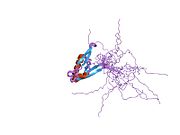PARD3B
Protein-coding gene in the species Homo sapiens
| PARD3B | |||||||||||||||||||||||||||||||||||||||||||||||||||
|---|---|---|---|---|---|---|---|---|---|---|---|---|---|---|---|---|---|---|---|---|---|---|---|---|---|---|---|---|---|---|---|---|---|---|---|---|---|---|---|---|---|---|---|---|---|---|---|---|---|---|---|
 | |||||||||||||||||||||||||||||||||||||||||||||||||||
| Identifiers | |||||||||||||||||||||||||||||||||||||||||||||||||||
| Aliases | PARD3B, ALS2CR19, PAR3B, PAR3L, PAR3LC, PAR3beta, Par3Lb, par-3 family cell polarity regulator beta | ||||||||||||||||||||||||||||||||||||||||||||||||||
| External IDs | MGI: 1919301; HomoloGene: 35389; GeneCards: PARD3B; OMA:PARD3B - orthologs | ||||||||||||||||||||||||||||||||||||||||||||||||||
| |||||||||||||||||||||||||||||||||||||||||||||||||||
| |||||||||||||||||||||||||||||||||||||||||||||||||||
| |||||||||||||||||||||||||||||||||||||||||||||||||||
| |||||||||||||||||||||||||||||||||||||||||||||||||||
| |||||||||||||||||||||||||||||||||||||||||||||||||||
| Wikidata | |||||||||||||||||||||||||||||||||||||||||||||||||||
| |||||||||||||||||||||||||||||||||||||||||||||||||||
Partitioning defective 3 homolog B is a protein that in humans is encoded by the PARD3B gene.[5][6][7]
Interactions
PARD3B has been shown to interact with Mothers against decapentaplegic homolog 3.[8]
References
- ^ a b c GRCh38: Ensembl release 89: ENSG00000116117 – Ensembl, May 2017
- ^ a b c GRCm38: Ensembl release 89: ENSMUSG00000052062 – Ensembl, May 2017
- ^ "Human PubMed Reference:". National Center for Biotechnology Information, U.S. National Library of Medicine.
- ^ "Mouse PubMed Reference:". National Center for Biotechnology Information, U.S. National Library of Medicine.
- ^ Hadano S, Hand CK, Osuga H, Yanagisawa Y, Otomo A, Devon RS, Miyamoto N, Showguchi-Miyata J, Okada Y, Singaraja R, Figlewicz DA, Kwiatkowski T, Hosler BA, Sagie T, Skaug J, Nasir J, Brown RH Jr, Scherer SW, Rouleau GA, Hayden MR, Ikeda JE (Oct 2001). "A gene encoding a putative GTPase regulator is mutated in familial amyotrophic lateral sclerosis 2". Nat Genet. 29 (2): 166–73. doi:10.1038/ng1001-166. PMID 11586298. S2CID 52828189.
- ^ Kohjima M, Noda Y, Takeya R, Saito N, Takeuchi K, Sumimoto H (Dec 2002). "PAR3beta, a novel homologue of the cell polarity protein PAR3, localizes to tight junctions". Biochem Biophys Res Commun. 299 (4): 641–6. doi:10.1016/S0006-291X(02)02698-0. PMID 12459187.
- ^ "Entrez Gene: PARD3B par-3 partitioning defective 3 homolog B (C. elegans)".
- ^ Warner DR, Pisano M Michele, Roberts Emily A, Greene Robert M (Mar 2003). "Identification of three novel Smad binding proteins involved in cell polarity". FEBS Lett. 539 (1–3). Netherlands: 167–73. doi:10.1016/S0014-5793(03)00155-8. ISSN 0014-5793. PMID 12650946. S2CID 7429554.
Further reading
- Izaki T, Kamakura S, Kohjima M, Sumimoto H (2006). "Two forms of human Inscuteable-related protein that links Par3 to the Pins homologues LGN and AGS3". Biochem. Biophys. Res. Commun. 341 (4): 1001–6. doi:10.1016/j.bbrc.2006.01.050. PMID 16458856.
- Benzinger A, Muster N, Koch HB, et al. (2005). "Targeted proteomic analysis of 14-3-3 sigma, a p53 effector commonly silenced in cancer". Mol. Cell. Proteomics. 4 (6): 785–95. doi:10.1074/mcp.M500021-MCP200. PMID 15778465.
- Izaki T, Kamakura S, Kohjima M, Sumimoto H (2005). "Phosphorylation-dependent binding of 14-3-3 to Par3beta, a human Par3-related cell polarity protein". Biochem. Biophys. Res. Commun. 329 (1): 211–8. doi:10.1016/j.bbrc.2005.01.115. PMID 15721295.
- Jin J, Smith FD, Stark C, et al. (2004). "Proteomic, functional, and domain-based analysis of in vivo 14-3-3 binding proteins involved in cytoskeletal regulation and cellular organization". Curr. Biol. 14 (16): 1436–50. Bibcode:2004CBio...14.1436J. doi:10.1016/j.cub.2004.07.051. PMID 15324660. S2CID 2371325.
- Ota T, Suzuki Y, Nishikawa T, et al. (2004). "Complete sequencing and characterization of 21,243 full-length human cDNAs". Nat. Genet. 36 (1): 40–5. doi:10.1038/ng1285. PMID 14702039.
- Warner DR, Pisano MM, Roberts EA, Greene RM (2003). "Identification of three novel Smad binding proteins involved in cell polarity". FEBS Lett. 539 (1–3): 167–73. doi:10.1016/S0014-5793(03)00155-8. PMID 12650946. S2CID 7429554.
- Strausberg RL, Feingold EA, Grouse LH, et al. (2003). "Generation and initial analysis of more than 15,000 full-length human and mouse cDNA sequences". Proc. Natl. Acad. Sci. U.S.A. 99 (26): 16899–903. Bibcode:2002PNAS...9916899M. doi:10.1073/pnas.242603899. PMC 139241. PMID 12477932.
- Gao L, Macara IG, Joberty G (2003). "Multiple splice variants of Par3 and of a novel related gene, Par3L, produce proteins with different binding properties". Gene. 294 (1–2): 99–107. doi:10.1016/S0378-1119(02)00681-9. PMID 12234671.
- v
- t
- e
PDB gallery
-
 1wg6: Solution structure of PDZ domain in protein XP_110852
1wg6: Solution structure of PDZ domain in protein XP_110852
 | This article on a gene on human chromosome 2 is a stub. You can help Wikipedia by expanding it. |
- v
- t
- e

















